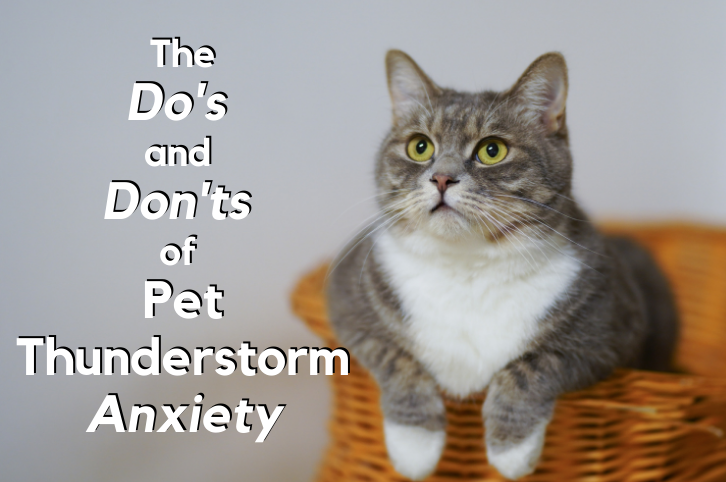It’s that time of year when pets fall under the frightening misconception that “THE SKY IS FALLING!” That’s right–it’s thunderstorm season. And for many pets, this time of year brings out their worst fears and anxieties. While you cannot explain to your pet that the sky, in fact, is not falling, there are some ways you can comfort your pet.
If you want to help your pet gain some relief from their storm anxiety, here are our recommended dos and don’ts:
1. Do Understand the Complexity of Storm Phobia Triggers
Thunderous blasts and the sky lighting up are the most apparent elements of a storm. And it’s reasonable for pets to be afraid of these. However, it’s more than just the light and noise of storms that cause our pets to be fearful.
As storms roll in, our pets have a natural ability to feel the barometric pressure change. They can also sense the increased static electricity in the air. They even feel the inaudible rumbles of thunder miles away.
These early warning signs of a storm begin to trigger panic attacks in many pets.
2. Do Not Assume Your Pet Will “Get Over It”
Our pets are hardwired with a fight-or-flight reaction to scary situations. This is due to “a freeze or jump into action” neurobiological mechanism in our pets’ brains (our brains, as well). This is why your pet runs and hides, may have a bathroom accident, or freezes up and begins shaking. They cannot help this response.
Over time, these anxieties do not go away on their own. In fact, the brain intensifies these reactions. So, as a pet owner, it’s vital to not ignore your pet’s symptoms and condition.
3. Do Call Us and Make an Appointment for Help
Many pet owners don’t realize that we will treat your pet’s physical and behavioral health needs. This includes storm anxiety. We are happy to chat with you about your pet’s individual symptoms and recommend tailored solutions. Dr. Plantz and the team will discuss medication and non-medication interventions that can help your pet gain some relief.
Some of the most common solutions we may talk to you about include:
- Behavioral supplements
- Prescription medications
- Dietary changes
- Exercise and mental stimulation
- Pheromone support
- Compression vests
4. Do Check the Weather Forecast and Plan Accordingly
Our pets can hear and feel with more sensitivity than we can. Furthermore, most anxiety-related medications need at least 2 hours to take effect. This makes checking the weather during summer vital.
If there’s a high chance of thunderstorms, prepare your pet by walking them early. Feeding them their dinner before the booms and blasts, and medicating them so they can gain a sense of calm before the clouds roll in.
5. Do Not Force Your Pet Out of Hiding
If your pet’s natural reaction to the unpredictable blasts of thunder is to hide beneath the bed or elsewhere, let them hunker down. Pulling your pet out of hiding can cause a spike in their anxiety. It can also result in a break of trust between you and your pet. Some pets may even try to hole up and defend their right to do so by lashing out with claws or worse.
It’s also a good idea to talk to your kids about this. When it comes to comforting pets, children have the best intentions. They often feel the need to try to snuggle a scared pet. Having a brief talk can clear up the confusion. If your child still wants to lend a hand, let them sit nearby where the pet is hiding and say sweet, soft, and comforting words to the pet.
To help your pet feel secure and safe, you can even build them an R-and-R den where they can retreat should they feel anxiety creeping in. Your pet spending time in this location will also let your kids know that your pet is struggling.
Don’t Let Thunderstorms Rain on Your Pet’s Peace of Mind
When it comes to your pet’s happiness and health, we’re here to help. We support pets and their owners when it comes to finding solutions to anxiety and other behavioral conditions. Before we experience the height of storm season, make an appointment to chat with Dr. Plantz about the best solutions for your best friend.
Image credit: Pexels


